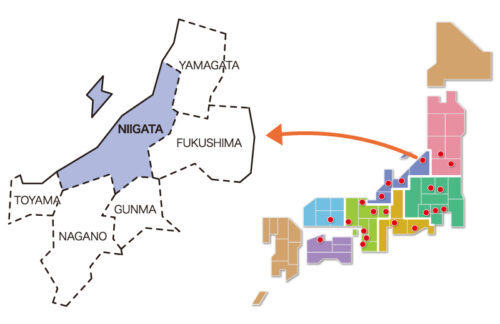Niigata Region

Compound textiles of synthetic & natural fibres
Niigata Prefecture has two major textile-producing areas around Nagaoka City: Tochio and Mitsuke. The history of the former - the Tochio textile region - is said to date back over 1,500 years, when tsumugi (pongees) were first made out of natural cocoons. Fast forward to the present day and the region specialises in producing wide-ranging fabrics that centre on medium-thick woven fabrics using both synthetic and natural fibres. The Mitsuke textile region, conversely, is known for its piece-dyed synthetic textiles and yarn-dyed cotton woven textiles and specialises in compound synthetic and natural textiles. Both regions have their own pongee specialties - ‘Tochio Tsumugi’ and ‘Mitsuke Yuki’ and both have produced their fair share of knitted fabrics since the war.
Tokamachi City, which is known for its heavy snowfall, also produces textiles, utilising its abundant snowmelt water for dyeing. It is also the spot where a tool for winding threads was discovered from the ancient ruins of the Yayoi Period (ca. 300 BC to 300 AD). Hemp fabrics have been produced here since times of yore, with a shift to silk fabrics emerging after the Meiji Period (1868-1912). Another renowned speciality of the city is ‘Tokamachi Gasuri’ (Kasuri), while Ojiya City is known for ‘Ojiya Chijimi’ (ramie crepe).
